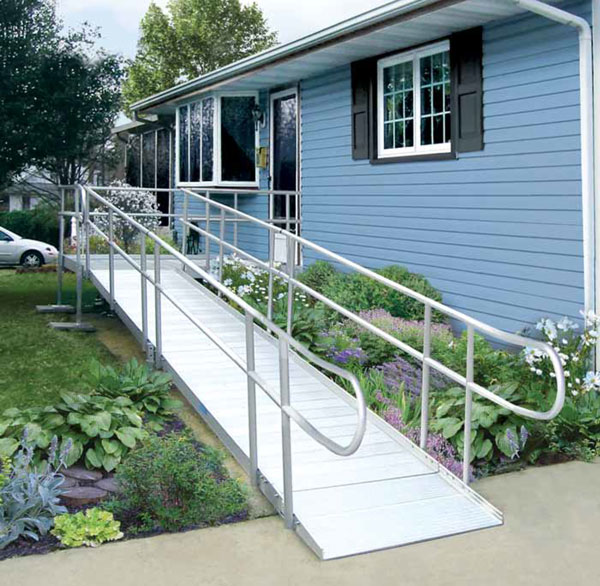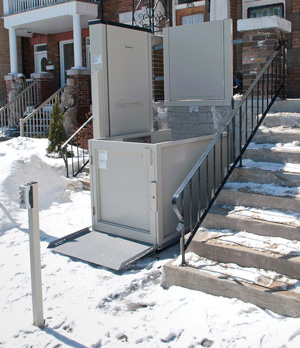Porch Lift Or Wheelchair Ramp?
A question I often get is whether to buy a porch lift or a ramp for wheelchair access to a house or building. There are several factors to consider in determining which is the best option for your particular circumstances.
The first issue I always look at is the height that needs to be overcome. The height isn’t a huge issue with a porch lift but it can be with a wheelchair ramp because it will determine the length of the ramp.
Wheelchair Ramp
In most jurisdictions in the US and Canada the building codes will require 1 foot of ramp for each inch of rise. So if you have a 24″ rise, you’ll have to build your wheelchair ramp at least 24′ long.
While 12″ to 1″ ratio is a pretty gentle slope for people in power wheelchairs or walking, it can be still a challenge for those using manual wheelchairs and building codes normally require a landing for the user to have a flat rest area at least every 30′. If your rise is 36″, your ramp will have to be 36′ long with a interim landing somewhere along it’s length. This landing can be at a 90 or a 180 degree turn or it can be in-line with no turn.
It's the length of the ramp which is normally the determining factor in whether the ramp is a better option than a porch lift.
The price of the ramp will increase as the length increases and at some point the cost will exceed the cost of installing a porch lift.
At what length will the wheelchair user be so tired after climbing the ramp that they won't bother to try in the first place?
The local climate will be a factor. If it is exposed to the weather it will need to be kept clear of ice and snow in northern climates. The longer the ramp the more work that will be.
Another climate factor is rain even if there is little chance of ice or snow. The longer the ramp the more likely you'll want to have some type of cover over it to keep the user dry which will add dramatically to the cost.
How much room there is for a ramp may be an issue. Most people do not have the room for a really long ramp.
The cost of the maintenance of the ramp will increase with the length; especially if the ramp is wooden.
Porch Lifts
Porch lifts, also known as vertical platform lifts, are self contained mini elevators which consist of a platform for carrying the wheelchair and user mounted to tower which houses all the electrical and mechanical parts used for lifting and lowering the platform.
They take up little space with a footprint of about 5′ by 6′ regardless of the height of the lift. Porch lifts come in standard sizes of 3′, 4′ and 6′ with some manufacturers offering extensions to achieve lifts of up to 12′ and higher. These sizes dictate the maximum travel of the lift and not the fixed height, so if you need a 43″ height you would order a 4′ lift and set it to stop at the 43″ level.
Porch lifts seem expensive at around $3,000 for a basic lift plus installation and, if needed, construction of a cement pad to put it on, electrical service and a self closing gate at the upper landing but can be less expensive than a long ramp. Another benefit of purchasing a porch lift over building a wheelchair ramp is they can be moved if the user moves and they have a resale value if the lift is no longer needed. I often get requests for used porch lifts but ramps are pretty much scrap when they aren’t needed any longer.
Porch lifts can be used in commercial applications but they can be more of a hassle than a ramp because of building codes and regulations. In my area commercial lifts must be licenced, have keyed access and be enclosed for safety. These requirements add to the cost and the commercial establishment must have someone control the keys and be available to attend users when they want to use the lift.
Conclusion
There is no right answer and in every instance the decision maker will have to balance the advantages and pit falls of each option. Price, climate, height, user abilities and room will all have to be considered when making the final decision.


 Online Vendors
Online Vendors  US Online Vendors
US Online Vendors 



